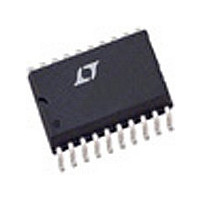LTC1753CSW#TRM Linear Technology, LTC1753CSW#TRM Datasheet - Page 17

LTC1753CSW#TRM
Manufacturer Part Number
LTC1753CSW#TRM
Description
Manufacturer
Linear Technology
Datasheet
1.LTC1753CSWTRM.pdf
(24 pages)
Specifications of LTC1753CSW#TRM
Lead Free Status / RoHS Status
Not Compliant
Available stocks
Company
Part Number
Manufacturer
Quantity
Price
APPLICATIO S I FOR ATIO
The ESR of the output capacitor forms a zero at the
frequency:
The compensation network at the error amplifier output is
to provide enough phase margin at the 0dB crossover
frequency for the overall closed-loop transfer function.
The zero and pole from the compensation network are:
Figure 7b shows the Bode plot of the overall transfer
function.
The compensation value used in this design is based on
the following criteria: f
the loop crossover frequency f
LC filter and the input resistor divider is compensated by
the gain of the PWM modulator and the gain of the error
amplifier (g
When low ESR output capacitors (Sanyo OS-CON) are
used, the ESR zero can be high enough in frequency that
it provides little phase boost at the loop crossover fre-
quency. Therefore, inadequate phase margin is obtained
for the system. This causes loop stability problems and
Figure 7b. Bode Plot of the LTC1753 Overall Transfer Function
f
f
ESR
Z
=
2 (R
=
2 (ESR)(C
f
mERR
Z
1
C
)(C
f
LC
)(R
1
C
)
U
C
).
f
and
OUT
ESR
SW
= 12f
)
U
f
f
f
SW
CO
P
=
= CLOSED-LOOP CROSSOVER
= LTC1753 SWITCHING
CO
CO
FREQUENCY
FREQUENCY
f
2 (R
CO
– 20dB/DECADE
, f
, the attenuation due the
Z
W
= f
1
C
)(C1)
LC
f
and f
P
respectively.
P
U
FREQUENCY
= 5f
1753 F07b
CO
. At
poor load transient response despite the improvement in
output voltage ripple.
To resolve this problem, a small capacitor can be con-
nected between the SENSE and V
zero pair in the loop compensation. The zero location is
prior to the pole location and thus, phase lead can be
added to boost the phase margin at the loop crossover
frequency. The pole and zero locations are located at:
where R12 is the parallel combination resistance of R1 and
R2. Choose C2 so that the zero is located at a lower
frequency compared to f
enough that the closed loop has enough phase margin for
stability. Figure 7c shows the Bode plot using phase lead
compensation around the LTC1753 internal resistor
divider network.
Although a mathematical approach to frequency compen-
sation can be used, the added complication of input and/
or output filters, unknown capacitor ESR, and gross
operating point changes with input voltage, load current
variations, all suggest a more practical empirical method.
This can be done by injecting a transient current at the load
and using an RC network box to iterate toward the final
compensation values, or by obtaining the optimum loop
Figure 7c. Bode Plot of the LTC1753 Overall Transfer Function
Using a Low ESR Output Capacitor
f
ZC2
=
2 (R2)(C2)
f
Z
f
LC
1
f
ZC2
and
CO
f
f
SW
CO
f
and the pole location is high
= CLOSED-LOOP CROSSOVER
PC2
= LTC1753 SWITCHING
FREQUENCY
– 20dB/DECADE
FREQUENCY
f
f
ESR
CO
=
FB
2 (R12)(C2)
pins to create a pole-
f
P
f
PC2
1
LTC1753
FREQUENCY
17
1753 F07c
1753fa













